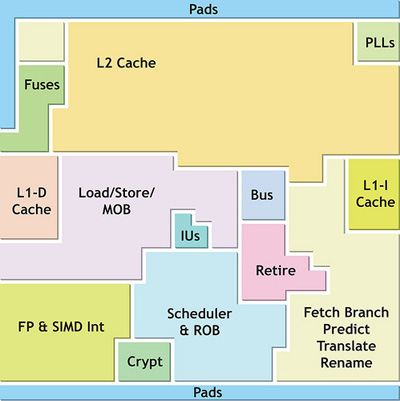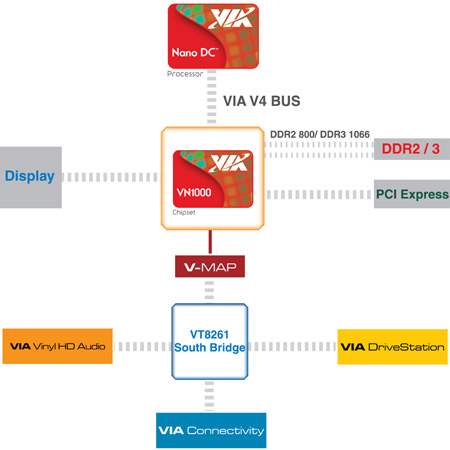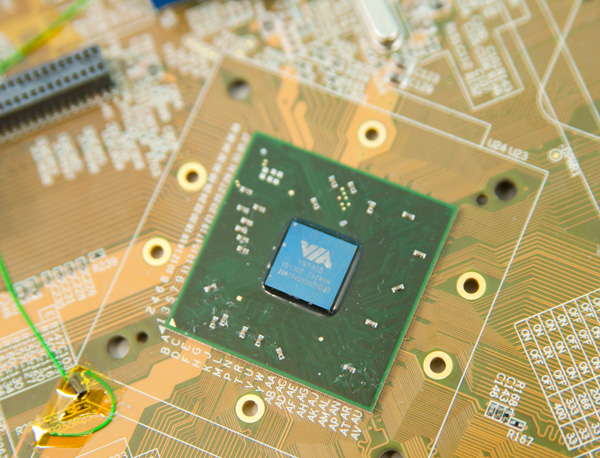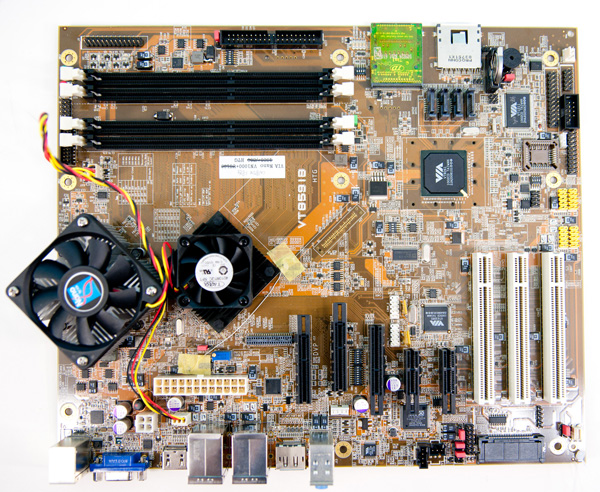VIA's Dual Core Nano & VN1000 Chipset Previewed
by Anand Lal Shimpi on November 15, 2010 12:26 PM ESTI haven’t had an official product briefing with VIA in years. The last time I met with a representative from the company was two years ago outside of IDF in San Francisco. Before then, it was probably around 4 years.
VIA was the first casualty of integration in the PC space. Today we’re all talking about moving graphics onto the processor die, but a few years ago we were having similar discussions about moving the memory controller and north bridge on die. As a manufacturer of chipsets (north and south bridges) for CPUs, VIA lost relevance in the x86 CPU market as the need for a third party chipset maker faded.
VIA’s recent visit to me in Raleigh, NC had two purposes according to the company. One, to remind me that VIA was still around and to give me some face to face time with a VIA representative (appreciated). And two, to showcase VIA’s dual-core Nano platform and brand new integrated graphics chipset (intriguing).
For those of you who don’t know, Nano is VIA’s answer to Atom, except it came along long before Atom did. Just like Atom, Nano was designed in Texas but by VIA’s Centaur team - a microprocessor company it acquired several years back. Centaur’s speciality was low power microarchitectures, and Nano is exactly that.

Compared to Atom, Nano is a bit of a beast. Both Atom and AMD’s Bobat core can fetch and issue up to two instructions. Nano can do three. Like AMD’s Bobcat, Nano has a full out of order execution engine. Atom, for the time being, is in-order.
The execution engine is well matched to the front end. Nano features seven dispatch ports and can retire up to three instructions per clock. In this sense, Nano is more like AMD’s Bobcat than Intel’s Atom. In fact, those two should be better matched than Atom vs. Nano.

VIA's Nano
Nano has other advantages over Atom. It features a hardware encryption engine. Something VIA introduced long before Intel’s AES-NI in Westmere. All of these features come at the expense of power consumption. Nano should be faster, but it draws more power than Atom.
VIA is a fabless semiconductor manufacturer, its Nano processor and associated chipset are both fabbed at TSMC in Taiwan. Nano is currently a 65nm design although VIA plans to take it to 40nm in 2011.
The dual-core Nano that VIA dropped off is architecturally identical to the existing Nano. Similar to the dual-core CPUs, DC Nano is literally two Nano die placed alongside one another. The L2 caches are private and all core-to-core communication happens externally via the Nano’s latest chipset: VIA’s VN1000. The dual-core die measures 8.5 mm x 16 mm (136mm^2 total area) on a 21 mm x 21 mm BGA package.
Ironically enough, VIA hasn’t integrated a memory controller into its own CPU design. Although to VIA’s credit, the CPU’s performance is competitive without it. I suspect VIA will deliver a more integrated version of Nano within the next 12 - 18 months.
While the dual core Nano improves competitiveness with Intel’s Atom, it’s the VN1000 that’s a huge step forward. These days everyone is talking about graphics and VIA is no exception. The VN1000 integrates S3’s Chrome 520, a brand new DirectX 10 GPU. VIA was light on architectural details other than to state that it has 32 stream processors and 4 texture sampling units. The VN1000 die is nearly as big as the CPU at 100mm^2 on a 65nm process. VIA claims that the 520’s performance is easily good enough for mainstream graphics.

Armed with a reference ATX motherboard, I was eager to verify those claims. Note that this review appears a lot later than expected as our original DC Nano reference board was damaged in transport. It wouldn't do anything beyond POST so what you're looking at is our second sample.













54 Comments
View All Comments
ckryan - Monday, November 15, 2010 - link
I recongnize that some people may totally write VIA off in this market, but don't overlook the fact that an improved shipping model of this board could at least cause Intel to rethink its Atom strategy. I really wanted an Atom system for a while, but then I realized for the same price as the setup I wanted, an i3/gigabyte mini itx system would be about the same price. A stripped down Atom board from Intel wouldn't be worthwhile at all, even if it is $80. In the business and mobile spaces, Atoms make a good argument. Its just a stale argument. AMD and VIA bringing more options to the market can't be called a bad thing. My hope is not just that VIA doesn't fail entirely, but that I have lots of interesting options in the near future.DanNeely - Tuesday, November 16, 2010 - link
Intel definitely could use a chip midway between the current atom and CULV product lines. The dual core atoms don't really help much; yeah they're better at decoding video that the GPU doesn't support, but the atoms general performance problems are single threaded in nature.Clocking the chip up to ~2.5ghz would probably help a good bit there but would probably blow the power budget out of the water.
Intel's stated that atom will remain in order for at least the first 4-5 years, so we shouldn't expect this to change. With intel primarily aiming atom at Arm's market share something that adds a lot of complexity to the chip is probably out of the question anyway.
A more efficient memory controller connection might help. The current implementation is on die FSB so there's definite room to improve here. How much this would help is something of an open question though. Outside of memory bound benchmarks the ~2x latency difference between the directly connected and on die FSB controllers in lga 1366 vs 1156 i7's wasn't very large; but as an in order CPU with a tiny cache memory latency is a bigger impact on the atoms performance, although this is partially balanced by it having a much lower load on the memory sub system due to is generally slow performance This might be the easiest place for Intel to speed things up though.
Alternatively the runtime gap between atom and CULV isn't that large, it might be possible to push it down into the current atoms power envelope even at atom drops into the higher end part of Arms territory.
danacee - Monday, November 15, 2010 - link
I remember reading an article last year from digit life that you can get some pretty massive performance gains on a Nano just by tricking your windows install into thinking its Intel. Seens the code handed to the nano is pretty shoddy even next to AMD.Anand, to get a true representation of the nano's performance I'm afraid you will have to do a cpu-z hack.
danacee - Monday, November 15, 2010 - link
found it;http://ixbtlabs.com/articles3/cpu/via-nano-cpuid-f...
sprockkets - Monday, November 15, 2010 - link
Why is there a "ATI Radeon HD 5450" in the power consumption graphs? That makes no sense. Where is the Athlon X2 3250e?Should compare the processor in this system, the Neo X2, if different:
http://www.newegg.com/Product/Product.aspx?Item=N8...
yuhong - Monday, November 15, 2010 - link
"Despite the typical omg-thisisntATI/NVIDIA error that some games always throw,"NT 4's CPUID code was full of such problems:
http://geoffchappell.com/viewer.htm?doc=studies/wi...
Even more recently, 64-bit Windows has a hardcoded list of CPU vendors it will run on, and will BSoD with UNSUPPORTED_PROCESSOR on any other vendor. An update had to be released to add CentaurHauls to the list.
Is there an option in the BIOS to fake a GenuineIntel CPU vendor?
Oxford Guy - Tuesday, November 16, 2010 - link
A fair and competitive marketplace!mschira - Monday, November 15, 2010 - link
The complete Via CPU story - long before they named it Nano - is essentially a story of not delivering.All these jesaya and what not platforms one could never really by them.
And yes Nano looks nice, the single core one didn't look to bad a year ago. But where is anything build with it that one can buy?
More competition? Great! but please make it to market.
Maybe now is the time Nvidia buys VIA.
M.
jo-82 - Tuesday, November 16, 2010 - link
Sorry, but my old Epia C7 sucks only 25W from the socket, and its fast enough for the job.LoneWolf15 - Tuesday, November 16, 2010 - link
When VIA comes out with a product, I really want to like it, and I want them to succeed. I actually got a cheapie notebook for a parent with a C7-M processor that worked well for quite some time until their needs grew. That said, here are my two issues."I should add that although the Chrome 520 GPU does support H.264 acceleration, I couldn't get it working with the driver drop I had on my test platform. CPU utilization would be low but I still dropped frames. I suspect this is a driver or software compatibility issue which I do expect VIA to rectify before the platform ships."
VIA (or should I say S3) has had many times where a graphics driver with bugs or compatibility issues that have delayed a product's potential after its release until it is no longer competitive with newer offerings. If the bugs aren't fixed at initial product release (I hope they are, but from experience...) that would be a huge strike against this.
"The DC Nano platform I tested is built on an old 65nm manufacturing process at TSMC. As a result, power consumption isn't that great. Also note that VIA doesn't do any power gating, so idle power ends up being very similar to Clarkdale"
If the Nano had power consumption that beat AMD but lost to Intel, I think we'd all be excited. Heck, if it matched AMD but with lower heat output, I think I still would be. However, we're looking at a product that cannot beat a Core i3 in performance, that equals it in power consumption. I think not doing power gating is a huge mistake here.
I hope the released product has the driver issue fixed, and I hope VIA can consolidate their architecture (i.e., turn a 2-core Nano into an SoC or at least a partial SoC) for power savings, lower expense, and maybe performance improvement. That said, I'll also believe it when I see it.